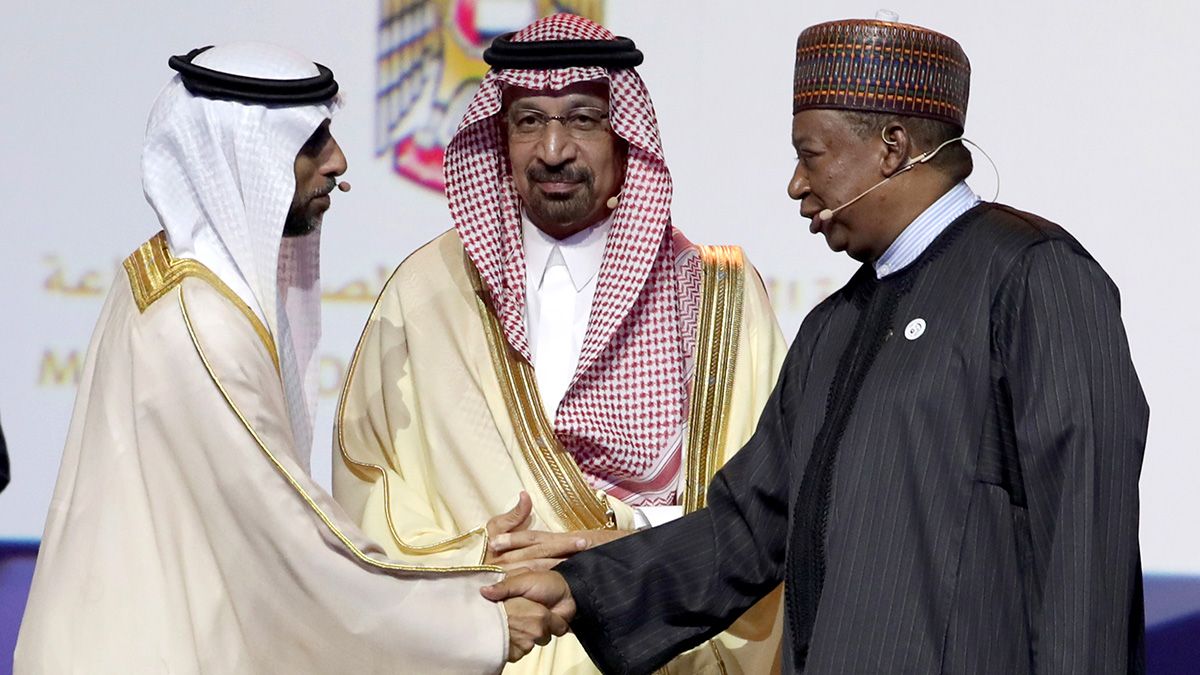Oil prices rose solidly for the first time in two months on Monday following Washington and Beijing’s truce agreement, Russia and Saudi Arabia’s pact and Canada’s commitment to cut oil production.
In early October, the international oil benchmark, Brent crude, had reached a four-year high of $83 a barrel, but fell by more than 30% to the $58 barrel mark when the supply of crude oil outstripped demand, and the global commodity sell-off ensued.
Monday’s rally has seen Brent prices climb back to above $61 a barrel, as Russia and Saudi Arabia agreed to extend their cooperation in managing oil output to 2019, with the details of any supply cuts to be determined today at the organisation of the petroleum exporting countries, also known as Opec, summit in Vienna.
$83
Cost per barrel at four-year high in early October
The rally was also prompted by the US-China 90-day trade war truce, which is expected to begin on 1 January, although investors are still uncertain whether the ceasefire will lead to a deal.
As the fifth biggest producer of oil in the world, Canada’s announcement that it would cut oil production by 325,000 barrels a day next year in Alberta to bolster prices also helped the rebound with the Western Canadian Select, which surged by 4% to nearly $53 a barrel.
As a result of the news, oil producers operating in Canada saw their share prices increase, with shares of Canadian Natural Resources [CNQ] up by more than 10%, while Athabasca Oil [ATH] shares rose more than 12%.
Stock prices in major oil and gas companies such as Shell [RDSA] and BP [BP] also had a boost, rising more than 2% on Monday, while North America’s West Texas intermediate rose by 4% to $52.95 a barrel.
Opec expected to cut oil production
While crude prices have continued to trade higher ahead of Wednesday’s final Opec meeting of the year, the group, made up of Middle Eastern, African and South American oil producers, is still worried about the emergence of a glut that could pull oil prices back down to their former lows.
Saudi Arabia continues to be Opec’s biggest crude oil producer, but the US became the largest producer of oil in the world in October, with President Trump determined to keep oil prices low.
Barclays said in a note to clients that oil production in Texas alone has grown by around 2 million barrels a day in a year to more than 11.5 million.
Ashley Peterson, oil analyst at Stratas Advisors, says that Monday’s positive news has been a long time coming. “Now that we’re here, we should see a big price correction going through the end of this week. The big question is, will Opec follow through?”, she said.
An Opec advisory body said last week that a production cut of 1.3 million barrels a day is needed to balance the market in 2019, which US bank Goldman Sachs expects it to agree to if it wants to reverse the “ongoing counter-seasonally large increase in inventories”.
“Now that we’re here, we should see a big price correction going through the end of this week. The big question is, will Opec follow through?” - Ashley Peterson, oil analyst at Stratas Advisors
However, analysts say that cutting anything less than 1.3 million barrels a day would set the stage for continued global oversupply next year and send oil prices lower.
While Canada’s call for producers to scale back oil output and the Russia-Saudi Arabia pact will both help Opec’s efforts to reign in emerging oversupply, the question is now whether Trump will play ball, or attempt to further increase US oil production in order to send prices back on a downward spiral.
Continue reading for FREE
- Includes free newsletter updates, unsubscribe anytime. Privacy policy





